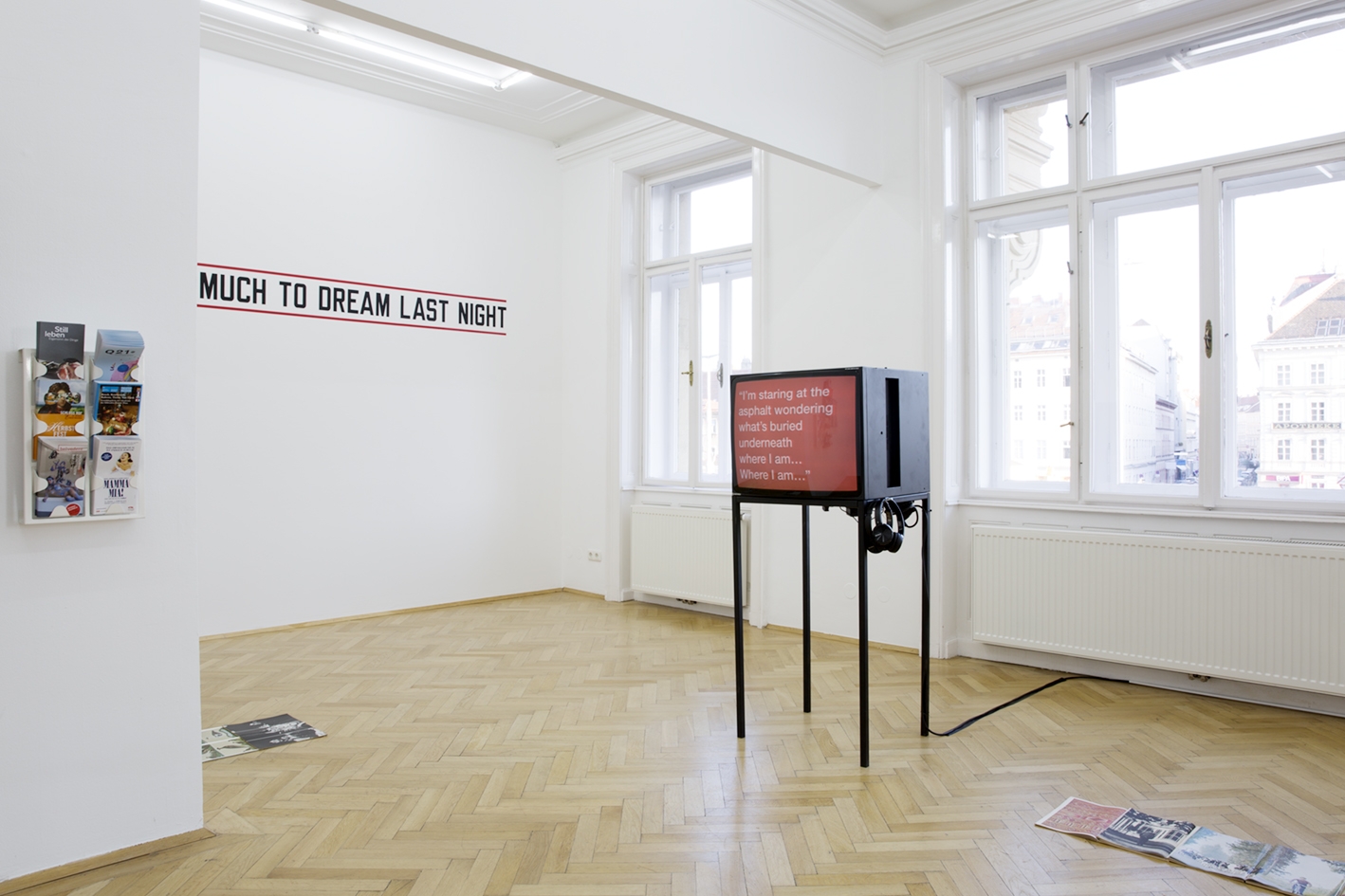This year, the organisers of the annual ‘curated by vienna’ festival, the Vienna Business Agency, decided the theme should be defined by the neologism ‘Viennaline’. With Could you visit me in dreams?, curator Attilia Fattori Franchini asks what it means to feel at home in this city – or any other – by exploring the unseen alienation felt by outsiders. The seven-artist exhibition’s centrepieces are three screens playing videos from the ‘travel notes’ – fragmentary reflections on contemporary politics, Viennese history and music culture – written by artist Tony Cokes during his last visit to the city 20 years ago. His observations ring true for foreigners living here, whose outsider status is often reasserted. ‘Many here are strangers,’ reads one such fragment, flashing up onscreen in yellow Helvetica against a black background, ‘like me.’
Franchini introduces a conflict into her interpretation of the wider festival theme by using the whole space. She uses works placed on the walls and floors, and makes the location a part of the drama, which contrasts with Cokes’s outsider status as an African-American man in a place ill at ease with its own narrow version of multiculturalism. The works are divided across two rooms (labelled A and B), and Franchini emphasises the fact that Galerie Nathalie Halgand is in a typically Viennese first-floor apartment – huge and light, with Jugendstil door handles and parquet floors. The space itself stars in Michèle Graf & Selina Grünter’s Eine Stadt wird gebaut, man benennt den Ort, der bedarf an nicht einsichtiger Konstruktion (2018), framed drawings of isometric views of Room B, hung in the very room they depict.
The works on the floor and walls are Nik Geene’s Only Planet (2018), L-shaped patterns made of copies of German travel magazine Merian, from 1969 to 1983, spread across the floor of both rooms, and Darren Bader’s Lawrence Weiner study/encomium (2018), Lawrence Weiner-style murals painted directly on the walls. The wall in Room A announces, ‘I had too much to dream last night’, while ‘mette spazio tra le cose’ (‘it puts space between things’) is written around the splendid doorframe into Room B.
Cokes’s videos are simple and stylish, but they tell nonlinear stories that ask for multiple viewings to get a sense of how they overlap. Each video is three minutes 14 seconds long, the length of a typical radio-friendly pop-song, accompanied by the music of British acts Burial, Mount Kimbie and Scritti Polliti. This not only reflects Cokes’s obsession with music, but emphasises how even the British, always ‘ex-pats’ and never ‘immigrants’, are deeply foreign here, strangers in a strange land.
The videos’ texts, taken from Cokes’s 2018 book The Vienna Guide, published by local imprint Sax Publishers, appear against bold red, yellow, black and blue backgrounds, and seem to shift almost randomly between subjects. Comments about Scritti Politti lead singer Green Gartside’s interest in Jacques Derrida are, for example, juxtaposed with an account of the Gestapo’s 1938 raid on Sigmund Freud’s Vienna home. The officers, we are told, maintained their classical Viennese obsequiousness even as they robbed and harassed Freud, referring to him ultra-politely as ‘Herr Professor’.
Cokes’s global outlook on local insularity is reflected in Gilli Tal’s Our Creative Heart (2018). This collection of flyer racks from newsagents, theatre foyers and Viennese café entrances contains leaflets for theatre and musical productions currently on show in the city, advertised as if brand-new even though widely performed elsewhere (the 1999 ABBA musical Mamma Mia, for example). Tal’s flyers, Bader’s murals and Cokes’s choice of music decentre us by reminding us that Vienna is not the whole world. Graf & Grünter’s drawings are, however, self-referential all the way down (space, gallery, city). Observations like Cokes’s give outsiders a rare, and essential, opportunity to understand how they fit in here. ‘In a foreign place with non-native people you feel totally safe,’ reads one note, ‘like you’re in the future. In a new, other Vienna’.
Could you visit me in dreams? at Galerie Nathalie Halgand, Vienna, 14 September – 13 October
From the December 2018 issue of ArtReview
